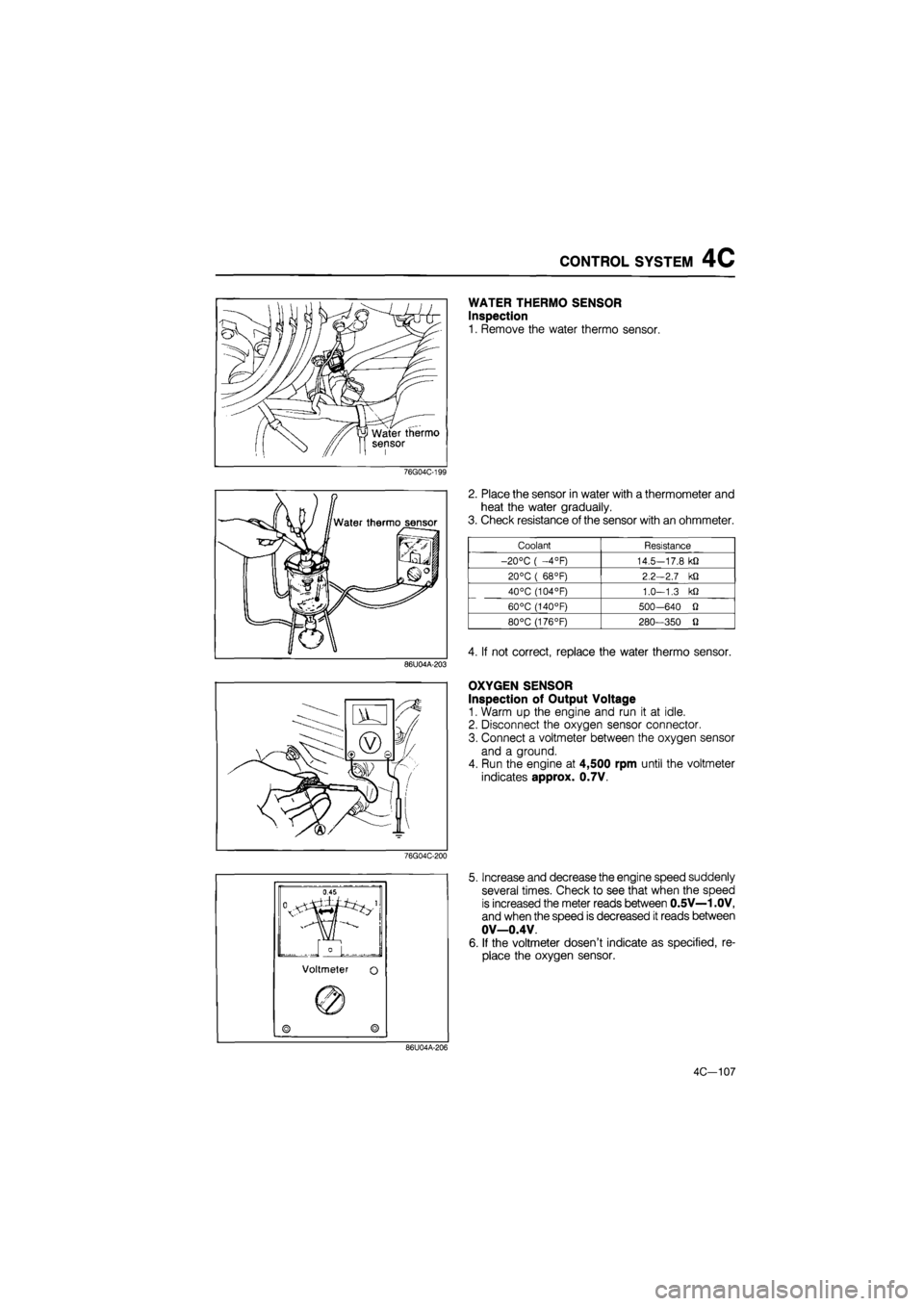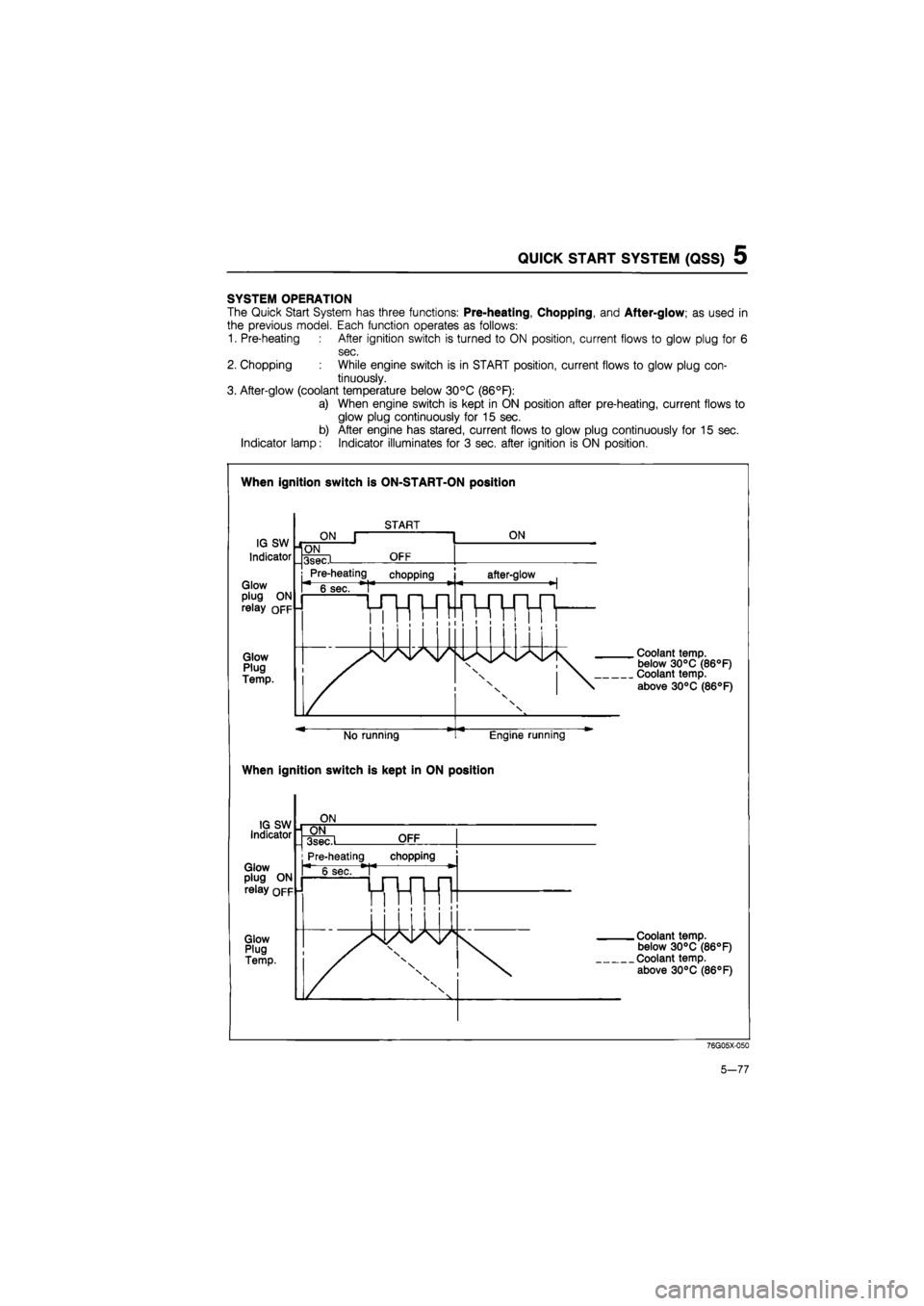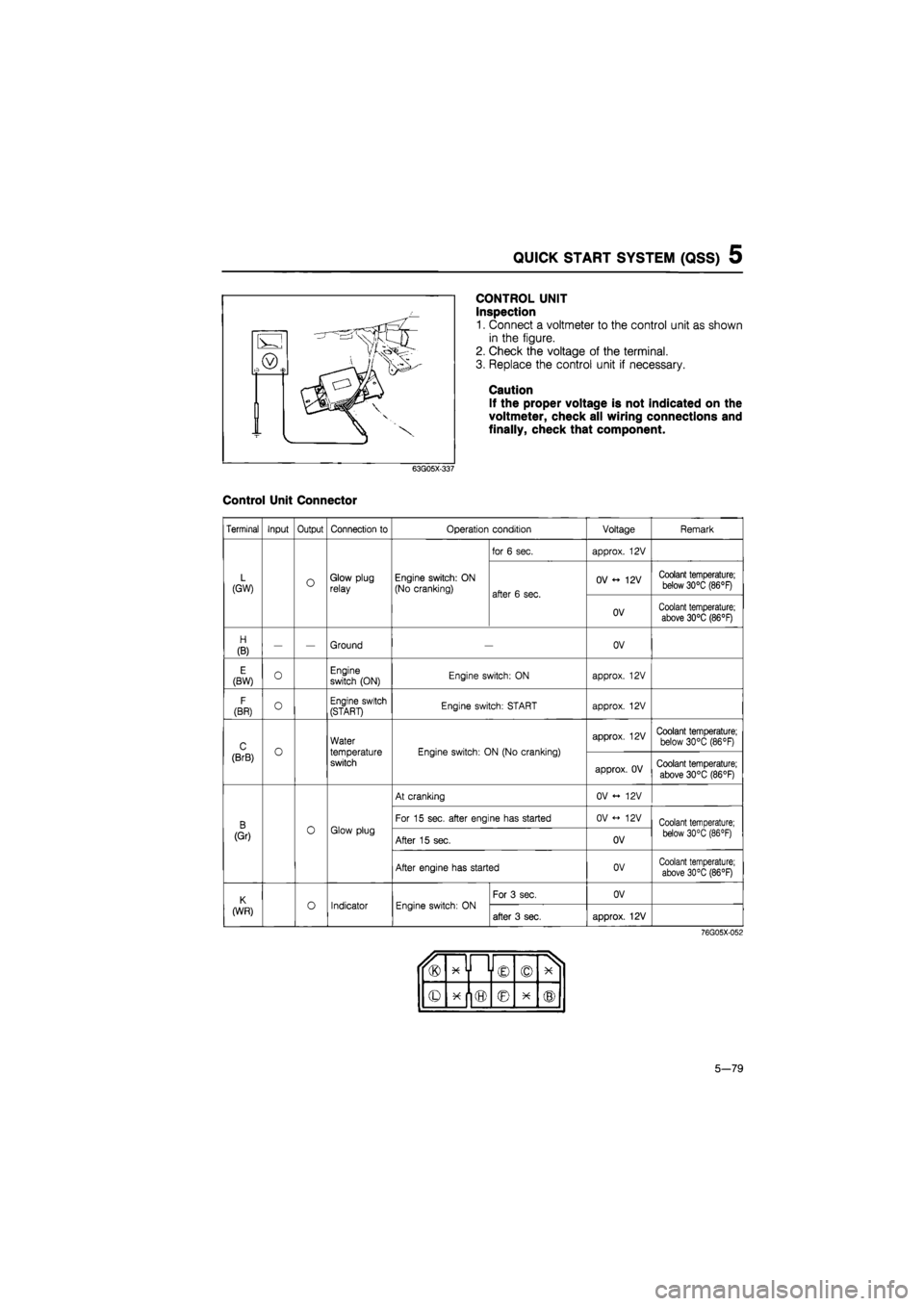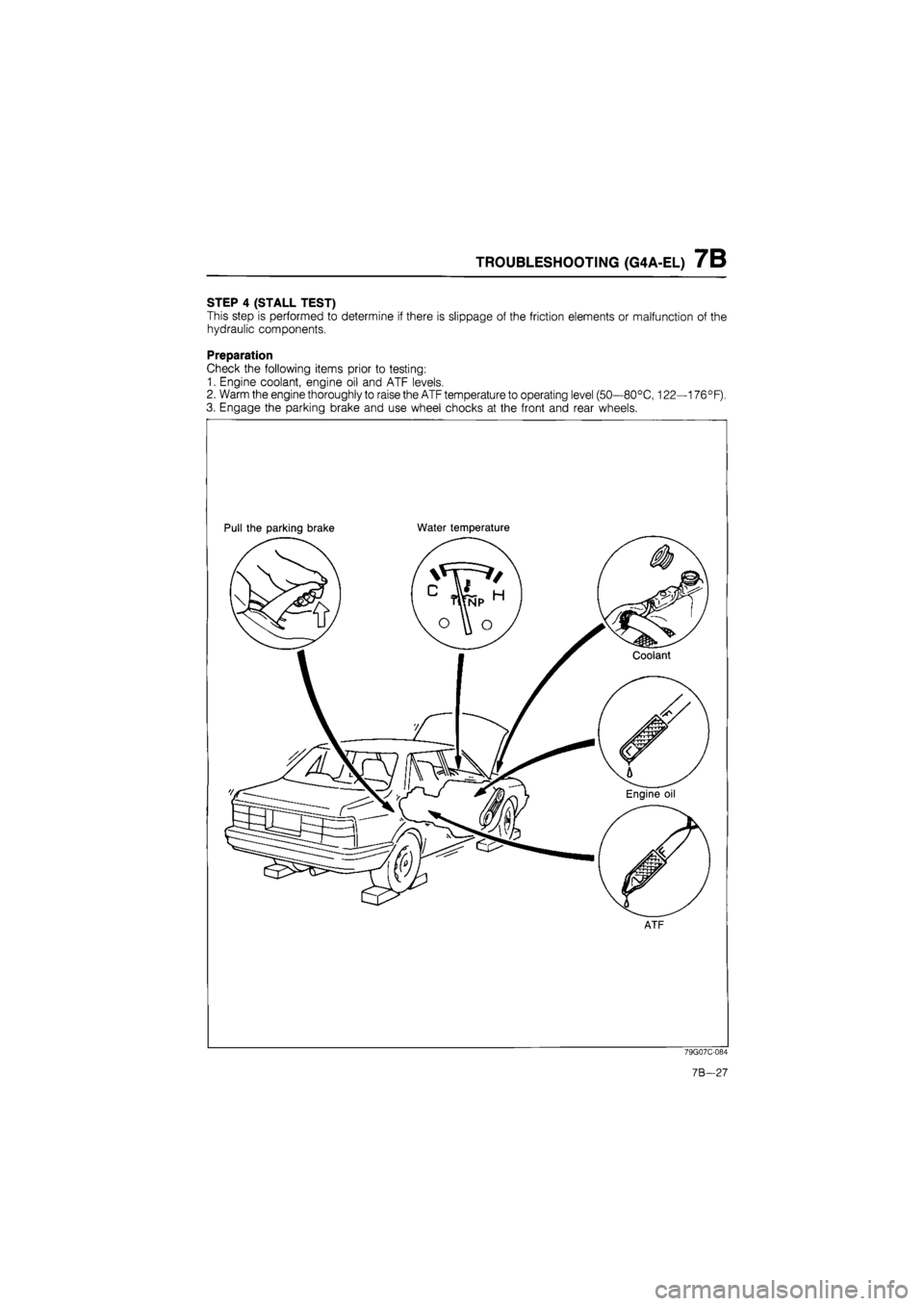coolant MAZDA 626 1987 Owners Manual
[x] Cancel search | Manufacturer: MAZDA, Model Year: 1987, Model line: 626, Model: MAZDA 626 1987Pages: 1865, PDF Size: 94.35 MB
Page 668 of 1865

CONTROL SYSTEM 4C
WATER THERMO SENSOR
Inspection
1. Remove the water thermo sensor.
76G04C-199
86U04A-203
2. Place the sensor in water with a thermometer and
heat the water gradually.
3. Check resistance of the sensor with an ohmmeter.
Coolant Resistance
-20°C ( —4°F) 14.5—17.8 kfl
20°C ( 68°F) 2.2-2.7 kQ
40°C (104°F) 1.0—1.3 kQ
60°C (140°F) 500—640 O
80°C (176°F) 280—350 fl
4. If not correct, replace the water thermo sensor.
OXYGEN SENSOR
Inspection of Output Voltage
1. Warm up the engine and run it at idle.
2. Disconnect the oxygen sensor connector.
3. Connect a voltmeter between the oxygen sensor
and a ground.
4. Run the engine at 4,500 rpm until the voltmeter
indicates approx. 0.7V.
76G04C-200
5. Increase and decrease the engine speed suddenly
several times. Check to see that when the speed
is increased the meter reads between 0.5V—1 .OV,
and when the speed is decreased it reads between
OV—0.4V.
6. If the voltmeter dosen't indicate as specified, re-
place the oxygen sensor.
86U04A-206
4C—107
Page 783 of 1865

QUICK START SYSTEM (QSS) 5
SYSTEM OPERATION
The Quick Start System has three functions: Pre-heating, Chopping, and After-glow; as used in
the previous model. Each function operates as follows:
1. Pre-heating After ignition switch is turned to ON position, current flows to glow plug for 6
sec.
2. Chopping While engine switch is in START position, current flows to glow plug con-
tinuously.
3. After-glow (coolant temperature below 30°C (86°F):
a) When engine switch is kept in ON position after pre-heating, current flows to
glow plug continuously for 15 sec.
b) After engine has stared, current flows to glow plug continuously for 15 sec.
Indicator lamp: Indicator illuminates for 3 sec. after ignition is ON position.
When ignition switch is ON-START-ON position
When ignition switch is kept in ON position
76G05X-050
5-77
Page 785 of 1865

QUICK START SYSTEM (QSS) 5
CONTROL UNIT
Inspection
1. Connect a voltmeter to the control unit as shown
in the figure.
2. Check the voltage of the terminal.
3. Replace the control unit if necessary.
Caution
If the proper voltage is not indicated on the
voltmeter, check all wiring connections and
finally, check that component.
63G05X-337
Control Unit Connector
Terminal Input Output Connection to Operation condition Voltage Remark
for 6 sec. approx. 12V
L (GW) O Glow plug relay Engine switch: ON (No cranking) after 6 sec.
OV 12V Coolant temperature; below 30°C (86°F) after 6 sec.
OV Coolant temperature; above 30°C (86°F)
H
(B) — — Ground OV
E (BW) 0 Engine switch (ON) Engine switch: ON approx. 12V
F
(BR) O Engine switch (START) Engine switch: START approx. 12V
C o
Water
temperature switch
Engine switch: ON (No cranking)
approx. 12V Coolant temperature; below 30°C (86°F)
(BrB) o
Water
temperature switch
Engine switch: ON (No cranking)
approx. OV Coolant temperature;
above 30°C (86°F)
At cranking OV <- 12V
B 0 Glow plug
For 15 sec. after engine has started OV <-> 12V Coolant temperature;
(Gr) 0 Glow plug After 15 sec. OV below 30°C (86 °F)
After engine has started OV Coolant temperature; above 30°C (86°F)
K o Indicator Engine switch: ON
For 3 sec. OV
(WR) o Indicator Engine switch: ON after 3 sec. approx. 12V
76G05X-052
u® x y i © © X 1
© © X ®
5-79
Page 891 of 1865

TROUBLESHOOTING (G4A-EL) 7B
Item Indication Condition Possible cause
BRAKE LIGHT SW ON Brake pedal depressed Brake light switch or
wiring BRAKE LIGHT SW
OFF Brake pedal released
Brake light switch or
wiring
WATER TEMP SW ON Coolant temperature 72°C (162°F) or above Water temp switch or wiring WATER TEMP SW
OFF Coolant temperature lower than 65°C (149°F)
Water temp switch or wiring
ATF TEMP SW ON ATF temperature 150°C (302°F) or above Fluid temperature switch or wiring ATF TEMP SW
OFF ATF temperature lower than 143°C (289°F)
Fluid temperature switch or wiring
CRUISE CONTROL SW Not used — —
Input (Digital display)
THROTTLE SENSOR
EC-AT control unit terminal voltage All the time Throttle sensor, idle switch or wirings
VEHICLE SPEED*
Vehicle speed calculated from speed sensor signal
All the time Vehicle speed sensor, speedometer cable, or wiring
DRUM SPEED* Drum speed All the time Pulse generator or wirings
Output (Light)
1-2 SOLENOID VALVE*
ON
Refer to page 7B—26 solenoid valve operation table
Control unit, 1-2 shift sol., or wiring 1-2 SOLENOID VALVE* OFF
Refer to page 7B—26 solenoid valve operation table
Control unit, 1-2 shift sol., or wiring
2-3 SOLENOID VALVE*
ON Refer to page 7B—26 solenoid valve operation table Control unit, 2-3 shift sol., or wiring 2-3 SOLENOID VALVE* OFF
Refer to page 7B—26 solenoid valve operation table Control unit, 2-3 shift sol., or wiring
3-4 SOLENOID VALVE*
ON
Refer to page 7B—26 solenoid valve operation table
Control unit, 3-4 shift sol., or wiring 3-4 SOLENOID VALVE* OFF
Refer to page 7B—26 solenoid valve operation table
Control unit, 3-4 shift sol., or wiring
LOCK-UP SOLE-NOID VALVE*
ON Lock-up condition Control unit, lock-up sol., or wiring LOCK-UP SOLE-NOID VALVE* OFF Non-lock-up condition
Control unit, lock-up sol., or wiring
HOLD INDICATOR ON Hold mode Control unit, Hold switch, or wiring HOLD INDICATOR OFF Other modes
Control unit, Hold switch, or wiring
MODE INDICATOR ON Power or economy mode Control unit, hold switch, mode switch, or wiring MODE INDICATOR
OFF Hold mode
Control unit, hold switch, mode switch, or wiring
NO LOAD SIGNAL Not used — —
76G07B-028
7B-25
Page 893 of 1865

TROUBLESHOOTING (G4A-EL) 7B
STEP 4 (STALL TEST)
This step is performed to determine if there is slippage of the friction elements or malfunction of the
hydraulic components.
Preparation
Check the following items prior to testing:
1. Engine coolant, engine oil and ATF levels.
2. Warm the engine thoroughly to raise the ATF temperature to operating level (50—80°C, 122—176°F).
3. Engage the parking brake and use wheel chocks at the front and rear wheels.
Pull the parking brake Water temperature
ATF
79G07C-084
7B-27
Page 900 of 1865

7B TROUBLESHOOTING (G4A-EL)
STEP 7 (ROAD TEST)
This step is performed to inspect for problems at the various ranges. If these tests show any problems,
adjust or replace by referring to the electronic system component or mechanical sections.
Caution
Perform the test at normal ATF operating temperature (50—80°C, 122—176°F).
D Range Test
Shift point, shift pattern, and shift shock
1. Shift the selector lever to D range and select the Power mode.
2. Accelerate the vehicle with half and full throttle valve opening.
Note
Throttle sensor voltage of the EC-AT Tester represents the throttle valve opening.
3. Check that 1-2, 2-3 and 3-OD up-shifts and downshifts and lock-up are obtained. The shift points
must be as shown in the D range (Power) shift diagram.
Note
a) Drum speed (rpm) of the EC-AT Tester represents the shift point.
b) Vehicle speed of the EC-AT Tester and speedometer and vehicle speed on a chassis
roller may not meet the specified shift pattern because of tire size. Therefore, check
the shift points with the Drum speed.
c) There is no lock-up when the coolant temperature is below 72°C (162°F).
d) There is no overdrive when the cruise control is operating and there is a 3 km/h (1.9
mph) difference between the pre-set cruise speed and vehicle speed, or set or resume
switch is ON.
e) There is no lock-up when the brake pedal is depressed.
4. Check the up-shifts for shift shock or slippage in the same manner.
5. While driving in OD, shift the selector lever to S range and check that 4-3 downshift immediately
occurs, then decelerate and check that engine braking effect is felt in only 3rd gear.
7B—34
Page 915 of 1865

TROUBLESHOOTING (G4A-HL) 7B
STEP 3 (STALL TEST)
This step is performed to determine if there is slippage of the friction elements or malfunction of the
hydraulic components.
Preparation
Check the following items prior to testing:
1. Engine coolant, engine oil and ATF levels.
2. Warm the engine thoroughly to raise the ATF temperature to operating level (50—80°C, 122—176°F).
3. Engage the parking brake and use wheel chocks at the front and rear wheels.
Pull the parking brake Water temperature
ATF
83U07B-038
7B—49
Page 919 of 1865

TROUBLESHOOTING (G4A-HL) 7B
STEP 5 (ROAD TEST)
This step is performed to inspect for problems at the various ranges.
If
these tests show any problems,
adjust or replace by referring to the mechanical sections.
Perform the test at normal ATF operating temperature (50—80°C, 122—176°F).
D Range Test
Shift point, shift pattern, and shift shock
1. Shift the selector lever to D range and depress the OD OFF switch.
2. Accelerate the vehicle with half (4/8) and full (8/8) throttle valve opening.
3. Check that 1-2, 2-3 and 3-OD up-shifts and downshifts and lock-up are obtained. The shift points
must be as shown in the D range shift diagram.
Note
a) Vehicle speed on a chassis roller may not meet the specified shift diagram because of
tire size.
b) There is no lock-up or OD when the coolant temperature is below 72°C (162°F), and when
the OD OFF switch is depressed.
4. Check the up and down shifts for shift shock or slippage.
5. While driving in 3rd (50—60 km/h, 31—37 mph) shift the selector lever to 2 range and check that
3-2 downshift immediately occurs, then decelerate and check that engine braking effect is felt in
2nd gear.
D range shift diagram
FE engine
Caution
8/8 n
-OD
0 20(12) 40(25) 60(37) 80(50) 100(63) 120(74) 140(87)
Vehicle speed km/h (mph)
76GC7B-057
7B—53
Page 1128 of 1865

7C TROUBLESHOOTING
STEP 2 (STALL TEST)
This step is performed to determine if there is slippage of the friction elements or malfunction of the
hydraulic components.
Preparation
Check the following items prior to testing:
1. Engine coolant, engine oil and ATF levels.
2. Warm the engine thoroughly to raise the ATF temperature to operating level (50—80°C, 122—176°F).
3. Set the parking brake and block the front and rear of the wheels.
Pull the parking brake Water temperature
ATF
7C—14
76G07C-024
Page 1648 of 1865

HEADLIGHT WASHER 14
HEADLIGHT WASHER
REMOVAL AND INSTALLATION
1. Remove in the sequence shown in the figure.
2. Install in the reverse order of removal.
76G14X-039
1. Bracket
2. Coolant reservoir
3. Bracket
4. Washer pump
5. Washer nozzles
6. Clips
7. Hose
8. Joint
9. Washer tank
14—97